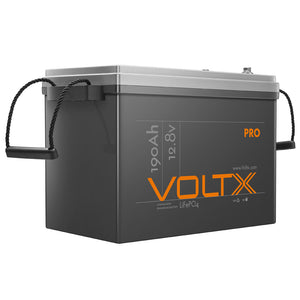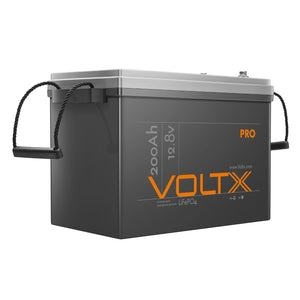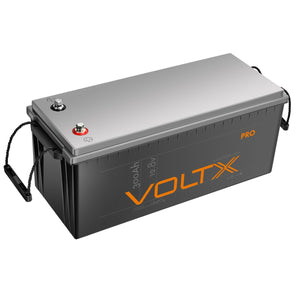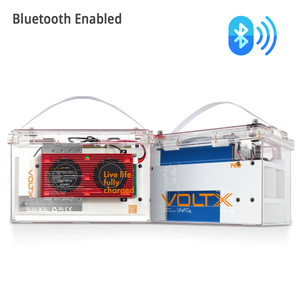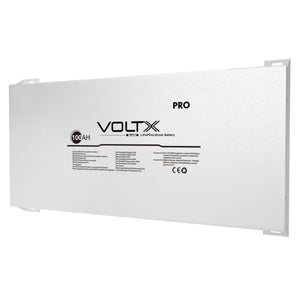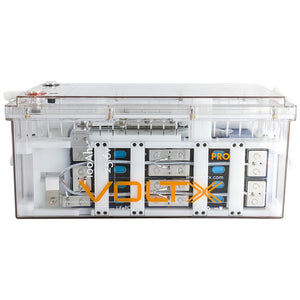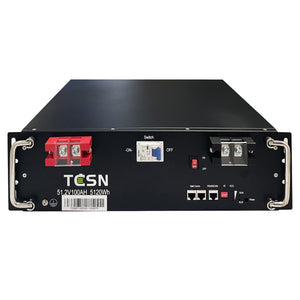VoltX 12V 100Ah Bluetooth Daly Lithium LiFePO4 Battery
Was$1,149.00Now $1,034.10Unit price /Unavailable
Deep Cycle Lithium Batteries
Deep cycle lithium batteries have revolutionised the power landscape in Australia, offering unparalleled reliability and longevity for those seeking dependable energy solutions. As more Australians embrace outdoor adventures and sustainable living, these advanced power systems have become increasingly essential components for everything from caravanning to off-grid setups.
Unlike traditional power options, deep cycle lithium batteries provide superior performance in demanding conditions whilst requiring minimal maintenance—perfect for Australia's diverse environments and power needs. Understanding the fundamental aspects of these batteries is crucial for making an informed investment, whether you're powering your weekend camping trip or establishing long-term energy independence in remote locations.
Understanding Deep Cycle Lithium Technology
Deep cycle lithium technology represents a significant advancement in portable power solutions, characterised by its ability to be regularly discharged to a substantial percentage of its capacity without damage—typically up to 80% compared to just 50% for traditional lead-acid alternatives. At the heart of modern deep cycle lithium batteries is Lithium Iron Phosphate (LiFePO4) chemistry, which has become the gold standard for stationary and mobile applications due to its remarkable stability and safety profile.
Unlike conventional lead-acid batteries, which suffer from sulphation when partially charged and lose capacity over time, LiFePO4 batteries maintain consistent performance throughout their lifespan and can be left at partial charge without degradation. The contrast between these technologies becomes particularly evident when examining their practical lifespan: whilst a quality lead-acid battery might manage 300-500 cycles, LiFePO4 batteries regularly deliver 2,000-5,000 cycles, fundamentally changing the value proposition despite their higher initial investment.
What Exactly is a LiFePO4 Battery?
A LiFePO4 battery represents the safest and most stable lithium chemistry commercially available, offering exceptional thermal and chemical stability compared to other lithium technologies. These batteries consist of lithium iron phosphate cathodes and graphite anodes, separated by a lithium-salt electrolyte that facilitates ion movement during charging and discharging. This specific chemistry creates inherently safer lithium battery cells that resist thermal runaway—the catastrophic chain reaction that causes fires in some other lithium technologies, making them ideal for enclosed spaces like caravans and boats where safety is paramount.
Deep Cycle vs Starter Batteries: A Clear Distinction
Deep cycle and starter batteries serve fundamentally different purposes in the power ecosystem. Starter batteries are engineered to deliver a powerful burst of current momentarily (such as when starting an engine) before being quickly recharged, with thin plates maximising surface area for rapid power delivery. In contrast, deep cycle batteries feature thicker plates designed to provide sustained, steady power over extended periods whilst enduring regular deep discharges. Attempting to use a starter battery for deep cycle applications inevitably leads to rapid plate degradation and premature failure, whilst using a deep cycle battery for starting applications may not provide sufficient cranking amps for reliable ignition in challenging conditions.
Key Advantages of Choosing Lithium Deep Cycle Power
The compelling benefits of deep-cycle lithium batteries make them increasingly the preferred choice for discerning Australian consumers seeking reliable portable power. For travellers exploring Australia's vast outback or coastal regions, these batteries offer a combination of performance characteristics that dramatically improve the off-grid experience. Their lightweight construction means less fuel consumption for towing vehicles, whilst their ability to deliver consistent power until nearly depleted ensures reliable operation of essential equipment like fridges and communication devices.
The exceptional efficiency of LiFePO4 chemistry with round-trip efficiency exceeding 95% compared to 70-85% for lead-acid alternatives means more of your generated power actually reaches your appliances, reducing generator run times and maximising solar harvesting. For Australians increasingly seeking self-sufficiency and reliability in their power systems, the benefits of LiFePO4 technology represent not just performance improvements but fundamental enhancements to lifestyle and capability.
Superior Lifespan and Durability
The extraordinary cycle life of deep cycle lithium batteries transforms the ownership experience, with quality LiFePO4 units regularly delivering 2,000-5,000 charge cycles compared to just 300-500 for premium AGM alternatives. This exceptional longevity translates directly into superior long-term value, as lithium battery systems often outlast multiple sets of lead acid batteries whilst maintaining consistent performance throughout their life. For Australians making significant investments in power infrastructure for their homes, caravans or boats, this extended service life significantly reduces the total cost of ownership despite higher initial purchase prices.
Lightweight and Compact Design
The dramatic weight reduction offered by lithium technology—typically 50-70% lighter than equivalent lead-acid batteries—creates cascading benefits for mobile applications. Lightweight deep cycle lithium batteries for caravans reduce towing weight, improving fuel economy and vehicle handling whilst freeing up payload capacity for other essentials. The compact, slim lithium battery footprint also enables flexible installation in space-constrained environments like boats and 4WDs, allowing for more efficient use of limited storage areas. This portability advantage extends to truly mobile applications, where carrying traditional batteries would be impractical for weight reasons.
Enhanced Efficiency and Performance
The superior power delivery characteristics of deep cycle lithium batteries revolutionise the user experience, maintaining steady voltage levels even at low states of charge, unlike lead-acid batteries, which experience significant voltage sag as they discharge. A quality 12V lithium battery will hold near-nominal voltage until approximately 80% discharged, ensuring stable operation of sensitive electronics throughout the discharge cycle.
The exceptional depth of discharge capabilities (typically 80-100% compared to 50% for lead-acid) effectively doubles usable capacity, whilst fast charging acceptance rates allow these batteries to recharge up to five times faster when sufficient charging power is available. This power efficiency makes lithium batteries particularly valuable in solar applications, where maximising energy capture and storage from limited sunlight is essential.
Selecting the Right Deep Cycle Lithium Battery for Your Needs
When you buy lithium batteries, understanding your specific requirements is essential for making an informed investment that will serve you reliably for years. Choosing the right size lithium battery involves careful assessment of your energy consumption patterns, available space, weight limitations, and budget constraints. In the Australian context, where remote travel and harsh conditions are common, selecting batteries with robust construction and appropriate protection systems becomes particularly important.
Whilst a 100Ah lithium battery might suffice for weekend camping, more extensive setups for extended travel or off-grid living might require 200Ah lithium battery capacity or larger. Although lithium battery price points initially appear higher than traditional alternatives, the calculation changes dramatically when considering the total ownership cost—including longer lifespan, reduced maintenance, and improved performance—making them increasingly the economical choice for informed consumers.
Calculating Your Power Needs: Capacity (Ah) Explained
Understanding battery capacity expressed in amp hours (Ah) is fundamental to properly sizing your system. This measurement indicates how much current a battery can provide over a specified period—typically 20 hours for deep cycle batteries. To calculate your requirements, list all appliances you'll power, their wattage, and daily runtime hours, then convert to amp hours by dividing wattage by voltage. For instance, running a 60W camping fridge for 24 hours requires approximately 120Ah of 12V battery capacity when accounting for depth of discharge limitations.
For typical Australian camping setups, a 100Ah lithium deep cycle battery often represents the sweet spot between capacity and portability, running essential equipment like fridges, lights, and occasional inverter use.
Voltage Considerations: 12V, 24V, or 48V
The voltage of your deep cycle lithium battery system should align with your existing equipment and overall power requirements. For most recreational applications in Australia, 12V lithium deep cycle battery systems remain the standard, offering compatibility with common camping and caravan equipment.
Larger installations often benefit from higher voltage systems—24V or even 48V—which reduce current flow and allow for smaller gauge wiring whilst improving efficiency for high-power applications. For solar installations, higher-voltage battery banks like the VoltX 24V 100Ah pro lithium LiFePO4 battery or 48V 100Ah pro lithium LiFePO4 battery configurations enable more efficient energy harvest and distribution in substantial off-grid systems.
Understanding Battery Management Systems (BMS)
The sophisticated Battery Management System (BMS) integrated into quality lithium batteries represents a critical safety and performance component that differentiates them from simpler lead-acid technologies. This intelligent protection circuit continuously monitors cell voltages, current flow, and temperature, preventing potentially damaging conditions like overcharging, over-discharging, short circuits, and thermal extremes.
Advanced models featuring Bluetooth Daily Lithium LiFePO4 battery management systems provide real-time monitoring through smartphone applications, allowing users to view precise state of charge, power flow, and cell health metrics. This comprehensive battery protection not only safeguards your investment but also simplifies usage by eliminating many of the maintenance concerns associated with traditional battery technologies.
Common Applications for Lithium Deep Cycle Batteries in Australia
The versatility of lithium deep cycle batteries has made them integral to numerous power applications across Australia's diverse landscapes and lifestyles. From powering remote homesteads to enabling extended marine adventures, these batteries have transformed what's possible in terms of mobile and off-grid power capability. The lithium camping battery has revolutionised the Australian outdoor experience, whilst lithium marine batteries have changed expectations for reliability on the water. Their compatibility with solar batteries systems has accelerated
Australia's transition to renewable energy, with batteries for solar panels becoming increasingly affordable and capable. As more Australians question what lithium batteries are used for, the applications continue to expand—from powering essential medical equipment in remote locations to enabling mobile businesses and supporting disaster resilience planning across the country's vast and sometimes challenging geography.
Powering Your Adventures: Caravans, Campers, and 4WDs
For Australia's passionate outdoor explorers, reliable caravan power has become non-negotiable, with lithium batteries transforming the self-sufficiency of mobile setups. A comprehensive 4WD battery setup built around lithium technology enables extended stays in remote locations, powering essential equipment like fridges, lighting, communications, and creature comforts without generator noise or fuel concerns. The slim form factor of options like a 12V 100Ah slim lithium LiFePO4 battery for caravan installations allows for creative mounting solutions, maximising limited space whilst providing substantial usable capacity.
Reliable Energy for Marine and Boating
The demanding marine environment presents unique challenges that lithium batteries are exceptionally well-suited to address. Their resistance to vibration, lightweight construction, and ability to deliver consistent power make them ideal for marine power applications ranging from house systems to electric trolling motors. A deep cycle lithium battery 12V system provides reliable energy for navigation equipment, lighting, refrigeration, and communication systems without the maintenance headaches associated with traditional boat battery options. Their ability to accept rapid charging from high-output alternators also means quicker recharging while engines are running, maximising time spent enjoying the water.
Off-Grid Living and Solar Energy Storage
The growth in sustainable living has driven demand for comprehensive off-grid battery system solutions that can reliably store and distribute renewable energy. Lithium solar batteries have become the backbone of these systems, offering efficient energy storage with minimal space requirements and exceptional cycle life. Whether powering a weekend cabin or a permanent off-grid residence, a lithium battery for solar system integration offers superior performance characteristics—maintaining high round-trip efficiency, accepting variable charging currents from solar controllers, and delivering stable output voltage regardless of state of charge.
Essential Tips for Maintaining Your Lithium Battery
Despite their reputation for being maintenance-free, implementing simple best practices can significantly extend the already impressive lifespan of deep cycle lithium batteries. Proper lithium battery maintenance primarily involves appropriate charging protocols and temperature management rather than the water level checking and equalisation charges required for traditional lead-acid units. The lithium battery rechargeable chemistry benefits from partial charging (unlike lead-acid batteries, which prefer full charging cycles), making them ideal for opportunistic charging from solar or shore power. With minimal self-discharge rates—typically less than 3% monthly compared to 10-15% for lead-acid alternatives—these batteries maintain charge during storage periods, further simplifying management for seasonal users.
Correct Charging Practices
Using a dedicated LiFePO4 charger designed specifically for lithium chemistry is essential for optimal performance and longevity. These specialised units provide the correct charging profile with appropriate voltage limits (typically 14.2-14.6V for 12V systems) and eliminate the equalisation and absorption stages used for lead-acid batteries, which can damage lithium cells. Quality battery charging systems often feature temperature compensation and multi-stage charging capabilities that automatically adjust to the battery's state of charge, maximising both charging speed and long-term capacity retention.
Storage and Temperature Considerations
Proper battery storage practices significantly impact long-term performance, particularly for seasonal users. For extended storage periods, maintaining a charge level between 40-60% (rather than fully charged) maximises cell longevity, whilst keeping batteries in moderate temperature environments (10-25°C) prevents accelerated aging. Although LiFePO4 chemistry handles temperature extremes better than other battery types, avoiding prolonged exposure to high heat significantly extends useful life, and most batteries include temperature effects protection through their BMS to prevent charging in freezing conditions which could damage cells.
Making the Smart Switch: Your Power Future
Investing in lithium batteries represents a forward-thinking approach to power management that aligns with Australia's growing focus on self-sufficiency and sustainability. The compelling advantages of deep cycle lithium batteries—exceptional lifespan, minimal maintenance requirements, superior performance, and decreasing cost—create a compelling value proposition for those seeking future-proof power solutions.
As technology continues advancing and production scales increase, these systems become increasingly accessible to mainstream consumers looking for reliable power solutions across recreational, marine, and residential applications. For Australians making decisions about energy independence or mobile power capability, deep cycle lithium batteries represent not just an upgrade from traditional technologies but a fundamental shift in how we think about and interact with stored electrical energy.
Frequently Asked Questions
-
What is a deep-cycle lithium battery?
A deep cycle lithium battery is a rechargeable energy storage device designed to be regularly discharged to a significant portion of its capacity (typically 80-100%). It uses lithium chemistry—most commonly LiFePO4 for deep cycle applications—to provide consistent power delivery over thousands of cycles, making it ideal for solar storage, marine use, and recreational vehicles.
-
How long do deep-cycle lithium batteries last?
Quality LiFePO4 deep cycle batteries typically deliver 2,000-5,000 complete charge cycles when properly maintained, compared to 300-500 cycles for lead-acid alternatives. This translates to approximately 7-10 years of regular use or 10-15 years for occasional weekend users—dramatically longer than the 2-3 year lifespan of comparable lead-acid batteries.
-
Are lithium batteries better than AGM for camping?
Yes, lithium batteries offer significant advantages over AGM for camping applications, including 50-70% weight reduction, twice the usable capacity (due to deeper discharge capabilities), consistent voltage output regardless of charge level, and dramatically longer lifespan. While the initial investment is higher, the total ownership cost is typically lower for frequent campers.
-
Can I use a regular car battery charger for a LiFePO4 battery?
No, standard car battery chargers designed for lead-acid batteries are not suitable for LiFePO4 charging. These chargers may include damaging equalisation phases or excessive voltage that can trigger the battery's protection systems or potentially damage cells. Always use a charger specifically designed for lithium LiFePO4 chemistry.
-
What size lithium battery do I need for my caravan?
Battery sizing depends on your specific power requirements, with most caravans well-served by 100-200Ah of lithium capacity. Calculate your daily power consumption by listing all appliances, their wattage, and daily runtime, then convert to amp-hours. For a typical setup running a fridge, lights, water pump, and occasional inverter use, 100Ah typically provides 1-2 days of autonomy.
-
Are lithium batteries safe?
LiFePO4 batteries are the safest lithium chemistry commercially available, featuring exceptional thermal stability and resistance to thermal runaway. Quality batteries include comprehensive battery management systems that prevent dangerous conditions like overcharging, short-circuits, and overheating. Unlike some other lithium chemistries, LiFePO4 won't combust even if physically damaged.
-
What does BMS stand for in a lithium battery?
BMS stands for Battery Management System—the sophisticated electronic protection circuit integrated into lithium batteries. This system continuously monitors cell voltages, current flow, and temperature to prevent potentially damaging conditions. The BMS balances cells during charging, disconnects power if unsafe conditions occur, and often provides diagnostic data for troubleshooting.
-
Can deep cycle lithium batteries be used in boats?
Absolutely—lithium marine batteries are ideal for boating applications due to their vibration resistance, lightweight construction, consistent voltage output, and ability to accept rapid charging from high-output alternators. Their minimal self-discharge rates also make them perfect for seasonal boating, maintaining charge during storage periods with minimal capacity loss.
-
What are LiFePO4 batteries used for?
LiFePO4 batteries excel in applications requiring deep cycling, longevity, safety, and weight efficiency. Common uses include recreational vehicles (caravans, campers, 4WDs), marine vessels, golf carts, solar energy storage, telecommunications backup, medical equipment, electric mobility devices, and remote monitoring stations. Their versatility makes them suitable for virtually any application requiring reliable, maintenance-free power.
-
Are lithium batteries worth the extra cost in Australia?
Despite higher initial lithium battery price points, their exceptional longevity (typically outlasting 3-4 sets of lead-acid batteries), superior performance, reduced weight, and minimal maintenance requirements deliver compelling value over their lifetime. For Australians regularly using their systems, particularly in remote areas where reliability is paramount, the added investment typically pays dividends through improved capability and reduced replacement costs.
-
How much lighter are lithium batteries compared to lead-acid?
Lightweight lithium batteries typically weigh 50-70% less than equivalent lead-acid alternatives. For example, a 100Ah lithium battery generally weighs 12-14kg, whilst a comparable lead-acid battery weighs 25-30kg. This significant weight reduction improves fuel efficiency in mobile applications and reduces structural requirements for mounting systems.
-
Do I need special wiring for a lithium battery system?
While lithium battery installation doesn't necessarily require special wiring compared to lead-acid systems, several considerations ensure optimal performance. Lower resistance cabling appropriately sized for maximum current flow prevents voltage drop, whilst circuit protection devices rated for lithium systems' higher current delivery capabilities are recommended. Existing wiring can often be utilised if properly sized and in good condition.
-
Can you buy different types of lithium batteries like slim or blade designs?
Yes, lithium technology enables diverse form factors beyond traditional battery shapes. Slim lithium battery designs offer reduced height for space-constrained installations, whilst blade lithium LiFePO4 battery configurations provide innovative drop-in solutions for existing battery compartments. These specialised formats allow flexible installation options whilst maintaining the performance advantages of lithium chemistry.

